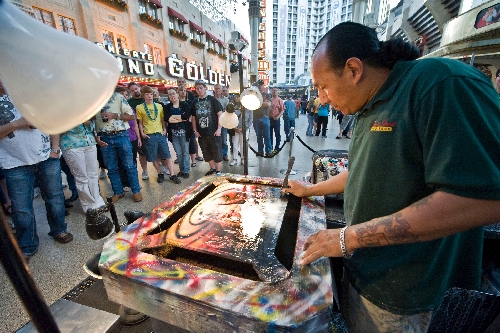Nevadan at Work: Spray-paint artist leaves stars behind to find his style
For about a decade, much of Tony Vegas' repertoire as a spray-paint artist stuck mainly to cosmic scenes of stars and planets.
Like others in the small coterie of artists who stick to spray cans and eschew brushes, he stuck to outer space because it was quick and easy, two critical qualities when your income depends on how many paintings you can sell at $40 each.
A few years ago, he decided it was time for a change. "I had to find my style," said Vegas. "I found nature landscapes without paint brushes. That's my style. Nobody else is doing it."
Since then, landscapes have been a best-seller for Vegas, one of the artists working under the canopy two nights a week on Fremont Street and one night a week at Harrah's. His seemingly frantic spray strokes and dashes, with details highlighted by box cutter blades and finger strokes, create a 16-inch-by-22-inch painting in just a few minutes and draw clusters of onlookers.
He first saw the style known as aerosol- grafia when he lived in Mexico City. He took it up gradually, through training from others in the genre and lots of practice.
About 20 percent of his income now comes from the website of Tony Vegas Art, through which he can take more detailed requests or create larger pictures than on the street.
Within the past couple of years, he has launched a line 3-D prints made from his spray paintings, following about the same time as 3-D televisions started showing up on shelves. When viewed through a pair of paper-frame glasses, the images pop out much like holograms.
"My living is art," he said. "Sometimes I am happy not making sales. I have to make a living, but what I like to do is painting."
Question: You said you didn't like spray-paint art when you first saw it. Why not?
Answer: At that time, though this was cheap stuff on streets of Mexico. They were painting on the streets and I was working on my nice sign shop. So I said, "No, that's not for me."
Question: What changed your mind?
Answer: I watched it and I got interested. These guys were creating paintings, but they weren't using brushes. And I told myself that I could do this air brushing, but not with spray cans, so I wanted to try it. It was not easy at the time because I didn't have the skills, the control. I was trying and trying and trying but not getting very far. Then I talked to the guy (Mexican artist Rafael Martinez) and he decided to train me, teach me some of the tricks. Then I got it. I started doing spray paintings in my sign shop and then I just decided to do it on the streets. And I liked it because that's for everybody, for kids, old people, everybody. Its not just for private companies or the rich.
Question: How do you figure out what people want?
Answer: People make requests every night. We try to figure out in minutes, sometimes seconds, how we can do it. I don't spend too much time thinking about a painting. We just start with the colors and get going. It comes from the heart, my experience, my feeling. Every night, we start with a list about 20 different paintings that we know real good. When people see what we can do, then they start making requests.
Sometimes they make weird requests. They think we are magicians and can do anything. Sometimes, we say no because it is hard to do it. But sometimes it's like a challenge. We don't like to say no. We like to make people happy. So sometimes we think and little bit and say, "If you don't like it, you don't have to buy the painting." But all the time people like it.
Question: What qualifies as a weird request?
Answer: Mixing cold colors with hot colors, like green and orange. There's no harmony. Some people don't have an idea what they want. Sometimes, we start painting and they say, "No, no, no. Can you change this a little bit. Can you change that." If you say a sunset, we know what to do. But if you say make a sunset with a deep blue sky and a big red moon, it's kind of hard.
Question: Do you also think of yourself as a performer?
Answer: Yes. I like to have big crowds in front of me, watching their faces, hearing them say, "Wow, how did he do this?" They get inspired by me, my painting. I see whole families watching the painting. We do a painting in less than eight minutes. A lot of people say this is one of the best free shows in Vegas.
Question: How long did it take to learn to work fast?
Answer: I did a couple days training with some friends, then practice every day, every day, every day and you get faster, faster, faster.
Question: What's your fastest painting?
Answer: I think four minutes.
Question: Do you think you will every get down to one minute?
Answer: Yes!
Question: What are your best-sellers?
Answer: Landscapes. Comic heroes like Spider-Man. Patriotic paintings like the Twin Towers in New York. Las Vegas city scenes. Sunsets are number one, all the time. The orange sunset is always the biggest seller.
Question: Fremont Street attracts all kinds of people. How do you deal with that, especially since you can't control it and have no protection?
Answer: That's something we learned on streets though the years. We talk to a lot of people from around the world. It just experience. It's a lot of psychology. You have to learn to deal with each person as an individual. There is no book, but just every day talking with people.
Question: What would you paint if you didn't need the money?
Answer: I like to do portraits. I have done them for a long, long time. Something weird is I have never done a portrait of my family. I have portraits of my pets because we love pets. I would do a big portrait of my family and pets.
Also, I would like to find new techniques, new art forms and keep working on that. I would do it just for fun and probably write a book about it to teach kids how to do it just for fun.
Question: What's your best technique for getting someone to buy a painting?
Answer: We don't go out and grab people and say, "Buy this." But we put people in trouble. If you are there with only 40 dollars in your pocket, I will put you in trouble. If there are eight or 10 people around and they are saying they like the painting, you will spend your 40 dollars on it.
Contact reporter Tim O'Reiley at toreiley@reviewjournal.com or 702-387-5290.
VITAL STATISTICS
Name: Tony Vegas
Age: 44
Occupation: Street and studio artist working entirely with spray paints. Owns Tony Vegas Art and works for Visual Art, which holds the Fremont Street and Harrah’s locations.
Quotable: “Sometimes (people) make weird requests. They think we are magicians and can do anything. Sometimes, we say no because it is hard to do it. But sometimes it’s like a challenge. We don’t like to say no. We like to make people happy.”
Family: Wife, Sophia; daughters, Jane and Joy.
Education: High school in Mexico City; private art school in Mexico City.
Work history: 1984, started his own sign-painting shop in Mexico City; about 1988, started doing spray-paint art in Mexico City; early 1990s, started doing spray-paint art at tourist destinations such as Acapulco and Puerto Vallarta; 1994, started working in a sign shop in Las Vegas, also started spray painting at venues like carnivals; about 10 years ago, started painting in the Boardwalk, Excalibur and the Stardust; returned to Las Vegas about four years ago after living in Palm Springs, began painting on Fremont Street and Harrah’s for Visual Art and his own business.
Hobbies: His pets, two dogs and three cats; looking for strays to turn over to animal shelters that do not practice euthanasia.
Favorite book: None, but reads about artists and musicians.
Hometown: Mexico City.
In Las Vegas since: 1994.
Visit www.tonyvegasart.com to see art by Tony Vegas.




























